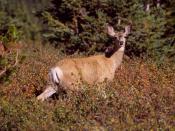Deer are the ruminant mammals that include the family Cervidae. Deer are also member of the order Artiodactyle, which means that they have hoofs with an even number of toes. Deer are among the most familiar animals of Washington and they can be found in many places around the world. There are about 100 types of deer, including the whitetail deer, reindeer, mule deer, elk, moose and black tail deer. Male deer and female reindeer grow and shed the new antlers each year; therefore, they are different from other horned animals such as antelope, which are in the same order as deer and may be superficially similar. Male deer are called bucks, bulls or stags. Female deer are called does or hinds. And young deer are called fawns or calfs.
Deer are generally lithe. They have long and compact bodies, powerful legs suited for rugged woodland terrain. Deer are also excellent jumper.
They are ruminant, so they have a four-chambered stomach. All deer have a liver without a gallbladder. Deer weights generally average from 30 to 300 kilograms, though the smallest species average 10 kilograms and the largest average 430 kilograms. Deer have small teeth in the front of the bottom jaw, which they use for tearing and breaking apart food. The teeth of deer are adapted to feeding on vegetation, like other ruminants, but they lack the upper incisors. Nearly all deer have a facial gland in front of each eye. The gland contains pheromone, which have a strongly scented, used to mark its home area. Deer also have their eyes on the sides of their head, which giving them a 310 degrees view. This wide view is hard for them to focus on one point. Deer have a good night vision, which is useful in the early morning...


